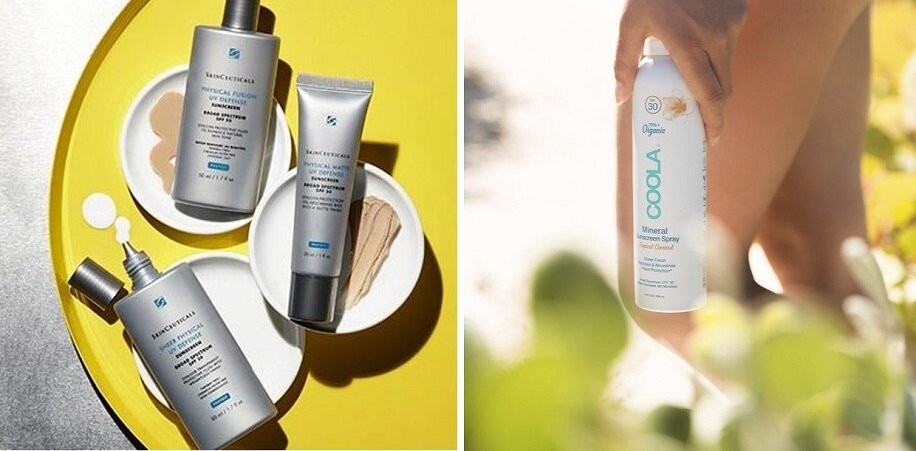Chemical Sunscreens: Are They Safe?
We’ve been told over and over to use sunscreen and not just to use it, but to use it in copious amounts and make sure we reapply it every few hours. But is it safe?First, it’s important to know that sunscreen comes in two basic categories: chemical and mineral. Chemical sunscreens are those that typically contain two to six of the following active ingredients: oxybenzone, avobenzone, octinoxate, octocrylene, homosalate, and octisalate. These sunscreens absorb harmful UV rays. Mineral sunscreens or physical sunscreens contain titanium dioxide and zinc oxide and deflect UV rays.Lately, there have been a number of reports about the health effects associated with chemical sunscreens and the ingredients avobenzone and oxybenzone, in particular. The concern is that these chemicals are being absorbed through the skin and entering the bloodstream at higher levels than previously believed. FDA researchers published a report this spring that there are potential risks associated to developing fetuses when pregnant women are exposed to oxybenzone at certain concentrations. In an abundance of caution, the American Academy of Pediatrics now states that it’s best to use only mineral sunscreens on children. So, should we throw out our chemical sunscreens? Maybe not just yet. It’s important to note that developing fetuses are also at risk to other chemicals we use daily, like retinol and salicylic acid, which are perfectly safe for adults. Pregnant women are told to avoid soft cheeses because the potential for listeria can be harmful to the fetus, but most of us eat brie and goat cheese with abandon at all other times. As of now, no study exists that shows that men or women using moderate amounts of chemical sunscreens are at increased risk for cancer or other health concerns. One study in 2001 fed rats oxybenzone daily. The rats had an increased uterine size of 23 percent. However, there is a big difference in ingesting a chemical and having it absorbed through the skin. A subsequent study showed that an average sized woman would have to apply oxybenzone to 100 percent of her body everyday for 35 years to get the same dose of oxybenzone as the rats did.
So, should we throw out our chemical sunscreens? Maybe not just yet. It’s important to note that developing fetuses are also at risk to other chemicals we use daily, like retinol and salicylic acid, which are perfectly safe for adults. Pregnant women are told to avoid soft cheeses because the potential for listeria can be harmful to the fetus, but most of us eat brie and goat cheese with abandon at all other times. As of now, no study exists that shows that men or women using moderate amounts of chemical sunscreens are at increased risk for cancer or other health concerns. One study in 2001 fed rats oxybenzone daily. The rats had an increased uterine size of 23 percent. However, there is a big difference in ingesting a chemical and having it absorbed through the skin. A subsequent study showed that an average sized woman would have to apply oxybenzone to 100 percent of her body everyday for 35 years to get the same dose of oxybenzone as the rats did. Why not just use mineral sunscreens? A couple of reasons. People need to use sunscreen every day. If people don’t like the consistency, they won’t wear it. Mineral sunscreens tend to be thicker and whiter in consistency, making it more difficult to rub in completely. The molecules are larger, making it more difficult to spread evenly. Missed spots are common. They also tend to sweat off more quickly and thus need to be applied more frequently.As a result, in test after test, mineral sunscreens have been found to be less effective than chemical sunscreens. It seems a more rational approach would be to alternate them. Or use a sunscreen with both filters. The dangers of skin cancer are well settled, and they can be deadly. A potential danger with unsettled science is not a good reason to jettison your sunscreen just yet. The best sunscreen is the sunscreen you’ll wear and re-apply…period.
Why not just use mineral sunscreens? A couple of reasons. People need to use sunscreen every day. If people don’t like the consistency, they won’t wear it. Mineral sunscreens tend to be thicker and whiter in consistency, making it more difficult to rub in completely. The molecules are larger, making it more difficult to spread evenly. Missed spots are common. They also tend to sweat off more quickly and thus need to be applied more frequently.As a result, in test after test, mineral sunscreens have been found to be less effective than chemical sunscreens. It seems a more rational approach would be to alternate them. Or use a sunscreen with both filters. The dangers of skin cancer are well settled, and they can be deadly. A potential danger with unsettled science is not a good reason to jettison your sunscreen just yet. The best sunscreen is the sunscreen you’ll wear and re-apply…period.

